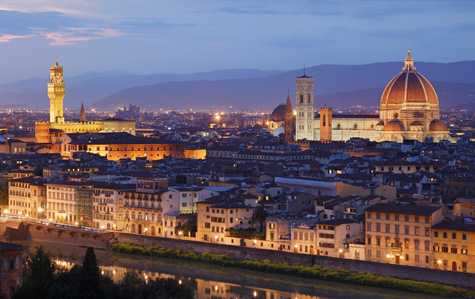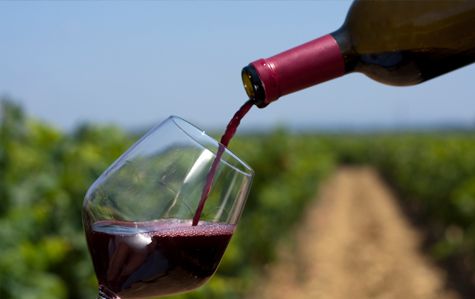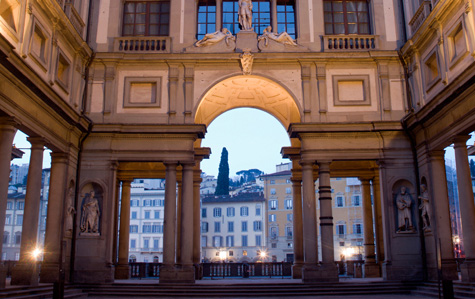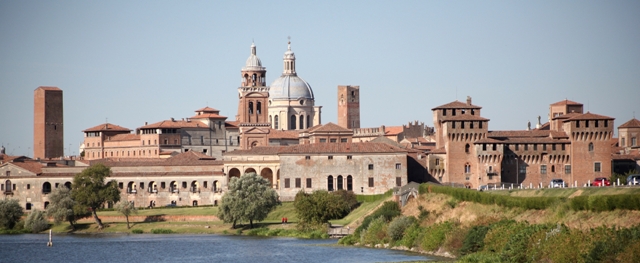Tour
EMILIA ROMAGNA
Bologna
This city is renowned for its culinary tradition and cured meats such as prosciutto, mortadella and salami. It has also given its name to the well-known meat-based pasta sauce called ragù alla bolognese. Here you will enjoy a walking tour with your guide who will enlighten you further on local delicacies. Bologna has one of the best preserved oldest parts of a town in Europe and from once 200 gender towers still 20 stands. Torre Asinelli and Torre Garisenda are the most beautiful among them. Another Highlight besides is the Piazza Maggiore to which connect all important buildings of the city. The beautiful fountain of Neptune stands on the square and in its south side there is the basilica San Petronius, the size parish church of the world in which Karl V was crowned to the emperor. Bologna is also known as a university town and it is interesting to visit the legendary lecture hall Theatre Anatomic in the old university.
Parma and Colorno
Your guide takes you to know the most important sights in the historic centre of Parma. You start with the marvelous view provided by Piazza Duomo, the cathedral square where the Baptistery and the Bishop’s Palace create a wonderfully evocative medieval setting. The Cathedral (XI-XII centuries) is one of the highest expressions of Romanesque architecture in the Po river plain. The Baptistery is one of the most important examples of the transition from the Romanesque to the Gothic style, built in pink marble with an octagonal layout. A stone’s throw from the Cathedral stands San Giovanni Evangelista, the Renaissance church of St John’s. It is certainly worth visiting the entire Monastery of St. John’s, with its fascinating renaissance cloisters and the Ancient Benedictine Apothecary’s.
In the afternoon, you reach Colorno where the Farnese built a magnificent summer residence at the beginning of 17th century. The duke's palace is also named small "Versailles". Luckily, the palace could be saved before the final decay and it is today after big restoration works a location for exhibitions and cultural events.
Modena and Maranello and Tasting of Aceto Balsamic
In this morning you will discover the lively city Modena. The center of life of the city is Piazza Grande, which paving made of cobblestones and its Ghirlandina tower, delimited to the north and east by the Cathedral and the Town Hall, was recognised by UNESCO as heritage of mankind. The Ducal Palace, whose construction began in 1634 on design of Avanzini, distinguishes itself as illustrious example of 18th century civil architecture and one of the largest Baroque palaces in Italy. From here you access the monumental staircase of honour adorned with Roman statues, which leads to the numerous rooms of the Estense Residence.
Afterwards visit of an Acetaia (production of the Balsamic vinegar). You will found out high interesting how is balsam vinegar produced in this family business since decades. The secret is transmitted by generation to generation. The procedure is very lengthy and possible because of the microclimate only in the region around Modena what explain, why the real Aceto Balsamic so expensively is. Then with an afternoon lunch with the owners you can still find out how many-sided of the Aceto Balsamic is applied in the Italian kitchen.
In the afternoon you visit the Ferrari museum in Maranello which is considered to driver of this world almost as a place of pilgrimage. Enzo Ferrari began in 1942 to produce machine parts and became so the founder of a myth. On the bases of photos, subjects and models is the history of the company and the formula 1 told. Naturally you can also admire the most famous Ferrari from the nearness, from the first certificate 125 up to the youngest model.
Ravenna
The visit, which becomes a fascinating exploratory expedition on the traces of lately Roman treasures of Ravenna, begins in the tomb of Galla Placidia and the orthodox baptistery. Both monuments come from the 5th century, the time when Ravenna residence was the west Roman emperor. Then follow the places which lay to the big Ostrogoths king Theodoric: his palace church, today named Sant'Apollinare Nuovo, his tomb and the Arian baptistery.
A splendid conclusion of the visit is the strange basilicas San Vitale and Sant'Apollinare in Classe, they have appeared by the middle of the 6th century, as Italy was under Byzantium.
Ferrara, Pomposa and Comacchio
Only in 7. - 10th century appeared at the top of that time of the Po Delta, experienced Ferrara an exceptional cultural flourish under the family Este who did this city an art, literature and way of life leading monarch's court of the renaissance. The oldest sight is the cathedral San Giorgio with its roman-Gothic facade. Vis à Vis there is the merlon-crowned Palazzo Comunale, seat of government Este, before they allowed building of 1385 on the mooted castle Castello Estense.
In the afternoon you go in the direction of Adriatic Sea. Po Delta considers the valuable abbey ensemble of Pomposa, with her beautiful frescoes, mosaic grounds and the bell tower of the abbey church S. Maria. Pomposa is known as a place of Birth of the music notes: the Benedictine Guido D'Arezzo designated in the 11th century the separate notes after the initial letters of a Gregorian hymn: UT queant laxis/Resonare fibris/Mira gestorum/Famuli tuorum/SOLve pulluti/Labii reatum/Sancte Ioannes.
On the way back you visit the picturesque lagoon city Comacchio, builds on 13 islands. Very interesting is the bridge Trepponti, a crossing of more streets about the confluence of two channels. The place is famous for its eels and as the most important fish market of the region.
Mantua and Sabbionetta
Today you move a little in Lombardy to visit the city Mantua, confesses by one of the most magnificent locks of Italy - the Palazzo Ducale. The splendid residence of the Gonzaga accommodates a row of important museums and collections. You visit the most important ones on your walk. In the Castello there is the Camera degli Sposi where you will admire the beautiful frescoes of Mantegna. In the centre of Mantua you visit the church Sant'Andrea, a principal work of the early renaissance and the Palazzo del Tè which was built by Giulio Romano as a pleasure palace for the Gonzaga.
Through the Po Land to typical poplar forests you further go to Sabbioneta. Beautiful city from an entirely available fortress wall surround in which today 300 live kind of people. The city is with its numerous art works a small jewel of the renaissance, so that in the 16th century it had become as the city duke's seat, one developed Sabbioneta to the ideal city.
Castle Torrechiara with visit of a cheese factory and Tasting of Parma Ham
This day offers a mixture of art and culinary. You reach the nearer surroundings of Parma to visit a cheese factory where the outstanding Parmesan " Parmigiano Reggiano " is produced which is called also the gold of the emilian milk farmers. First you visit the most beautiful castle of Emilia Romagna: the castle of Torrechiara. Already from wide you see the impressive castle arrangement. It was built in 1460 by the knight Pier Maria Rossi as a love nest: in the picture book she could not be more romantic. This castle over the river valley of the Parma is a magnificent example of Italian fortress architecture. Among other things, you will admire inside the "Camera d'Oro", the tower room richly decorated with frescoes and Terracotta dine which the lord of the castle allowed to build for his lover.
Not so far from here, you reach the village Langhirano, where you will visit the homeland of the Prosciutto di Parma. You will know how the first-class Parma ham is produced and of course you can taste it with a glass of wine.
Piacenza and abbey San Colombano
A charming hill area accompanies you on your journey in the province Piacenza: vineyards, locks, old places and picturesque to the Middle Ages style copied, village. It lies on the right bank of the Po, predominantly medieval stamped. The city of Piacenza was very important at the moment of the city states and the renaissance as it was duchy in 1545, under the Farnesi family.
From it rich past generate a multiplicity of buildings from the middle Ages and the renaissance time. The most important ones are the Romanesque cathedral, the church "San Sisto" and the "Palazzo Farnese" from the renaissance, as well as the basilica "San Antonio" from the 11th century.
The "Palazzo Comunale" or also named "Palazzo Gotico" , from the 14th century, is one of the shimmering buildings and the pride of the city. Before the palace, stand two Horse statue of the Farnesi. In Val Trebbia emerges Bobbio, a village established in the middle Ages around the abbey San Colombano which is known as Ponte Gobbo. There one finds architecture of big value, such as the basilica San Colombano, the cathedral and the castle.
Monteveglio with small hiking and wine tasting
For the conclusion of a stay in Emilia Romagna you have to undertake the possibility of a small hiking in the surroundings of the place Monteveglio. It appeared on a hill as a fortress arrangement which was considered once as impregnable. Near the castle there is the Romanesque abbey Santa Maria Assunta, of big interest and offers a beautiful look over the surrounding valleys. After a small hiking through the wine-growing area you reach a vineyard where a strengthening afternoon lunch and a wine tasting wait for you.
Busseto, Soragna and Fontanellato
Busseto lies on the flat country in the north from Emilia Romagna, is an important agriculture centre and an ideal exit place on the traces of the composer Giuseppe Verdi (1813-1901). He was born near the convenient village Roncole and he had spent most time of its life in Busseto. The figure of the composer fascinates not only for his music, however, also for his deeply integration with the historic time of Italian Risorgimento.
The fortress of Pallavicini from the fourteenth century stands on the Piazza Verdi where also his statue is. In its right wing was the Teatro Verdi (1857-1868) built by the draft of Pier Luigi Montacchini in neo-Gothic style.
His birthplace in Roncole is a modest building where you can get some souvenirs of the artist. In the parish church there is the organ with which the artist played his first chords.
In Saint Agatha lies the summer residence which bought Verdi in 1848, where the original arrangement "style Louis Philippe" is to be seen still today.
You go further to Fontanellato, a small village from the Longobardi time, well know because of its impressive and still well preserved "San Vital" fortress. It was built by the family San Vital.
The true treasure of the castle is in the ground floor: the room of Diana and Actaeon, in 1524 from Parmigianino, Paola Gonzaga and Galeazzo Sanvitale painted.
Fontanellato also represents an important aim for the pilgrims: visit its parish church in the Romanesque style with wood vestry, the church from S.Gaetano completely restored and the sanctuary of blessed Maria. Afterwards you visit Soragna, with its impressive fortress which was built in 1198 by the Meli Lupi family. Still today is the Rocca in the family estate and their magnificent rooms with frescoes and antique piece of furniture fascinating the guests.
FORLI ' AND CESENA
The province of Forlì Cesena applies from Adriatic Coast till hinterland where both capitals of the province rise, geographically divided, but together joint by a rich and fertile area, antique traditions, which themselves have survived until today with a history richly in important cultural and artistic Events.
The visit of Cesena brings in close contact with the culture of the Italian humanism. In the oldest part of the town centre of Cesena there is an international important treasure, the library "Malatestiana" from the year 1452, one of the biggest symbols of the culture from the renaissance.
The period of bloom of the city Forlì is closely connected with another important period of the Italian history: the Risorgimento. Many heroes who have changed the history of Italy came from Forlì, therefore, most of the public squares, historic route and important monuments are dedicated to them.
The local palace is on the central square "Piazza Saffi" where stands the statue of Aurelio Saffi - of a historic personality which played together with Giuseppe Mazzini, who had an important role in the political and social events of the Italian 19th century.
To get a complete visit of Forlì, one Must is an excursion to the wall ring "Rocca Sforzesca".











